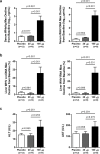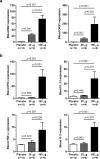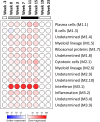Intrahepatic Transcriptional Signature Associated with Response to Interferon-α Treatment in the Woodchuck Model of Chronic Hepatitis B
- PMID: 26352406
- PMCID: PMC4564242
- DOI: 10.1371/journal.ppat.1005103
Intrahepatic Transcriptional Signature Associated with Response to Interferon-α Treatment in the Woodchuck Model of Chronic Hepatitis B
Erratum in
-
Correction: Intrahepatic Transcriptional Signature Associated with Response to Interferon-α Treatment in the Woodchuck Model of Chronic Hepatitis B.PLoS Pathog. 2016 Mar 29;12(3):e1005541. doi: 10.1371/journal.ppat.1005541. eCollection 2016 Mar. PLoS Pathog. 2016. PMID: 27022978 Free PMC article. No abstract available.
Abstract
Recombinant interferon-alpha (IFN-α) is an approved therapy for chronic hepatitis B (CHB), but the molecular basis of treatment response remains to be determined. The woodchuck model of chronic hepatitis B virus (HBV) infection displays many characteristics of human disease and has been extensively used to evaluate antiviral therapeutics. In this study, woodchucks with chronic woodchuck hepatitis virus (WHV) infection were treated with recombinant woodchuck IFN-α (wIFN-α) or placebo (n = 12/group) for 15 weeks. Treatment with wIFN-α strongly reduced viral markers in the serum and liver in a subset of animals, with viral rebound typically being observed following cessation of treatment. To define the intrahepatic cellular and molecular characteristics of the antiviral response to wIFN-α, we characterized the transcriptional profiles of liver biopsies taken from animals (n = 8-12/group) at various times during the study. Unexpectedly, this revealed that the antiviral response to treatment did not correlate with intrahepatic induction of the majority of IFN-stimulated genes (ISGs) by wIFN-α. Instead, treatment response was associated with the induction of an NK/T cell signature in the liver, as well as an intrahepatic IFN-γ transcriptional response and elevation of liver injury biomarkers. Collectively, these data suggest that NK/T cell cytolytic and non-cytolytic mechanisms mediate the antiviral response to wIFN-α treatment. In summary, by studying recombinant IFN-α in a fully immunocompetent animal model of CHB, we determined that the immunomodulatory effects, but not the direct antiviral activity, of this pleiotropic cytokine are most closely correlated with treatment response. This has important implications for the rational design of new therapeutics for the treatment of CHB.
Conflict of interest statement
I have read the journal's policy and the authors of this manuscript have the following competing interests: SPF, DJC, LG, HB, ER, PR, DCS, FB, RS, SHL, EK, JC, MT are/were employees of Hoffmann-La Roche, Inc. (
Figures








References
-
- Lavanchy D (2004) Hepatitis B virus epidemiology, disease burden, treatment, and current and emerging prevention and control measures. J Viral Hepat 11: 97–107. - PubMed
Publication types
MeSH terms
Substances
Associated data
- Actions
Grants and funding
LinkOut - more resources
Full Text Sources
Other Literature Sources
Molecular Biology Databases

